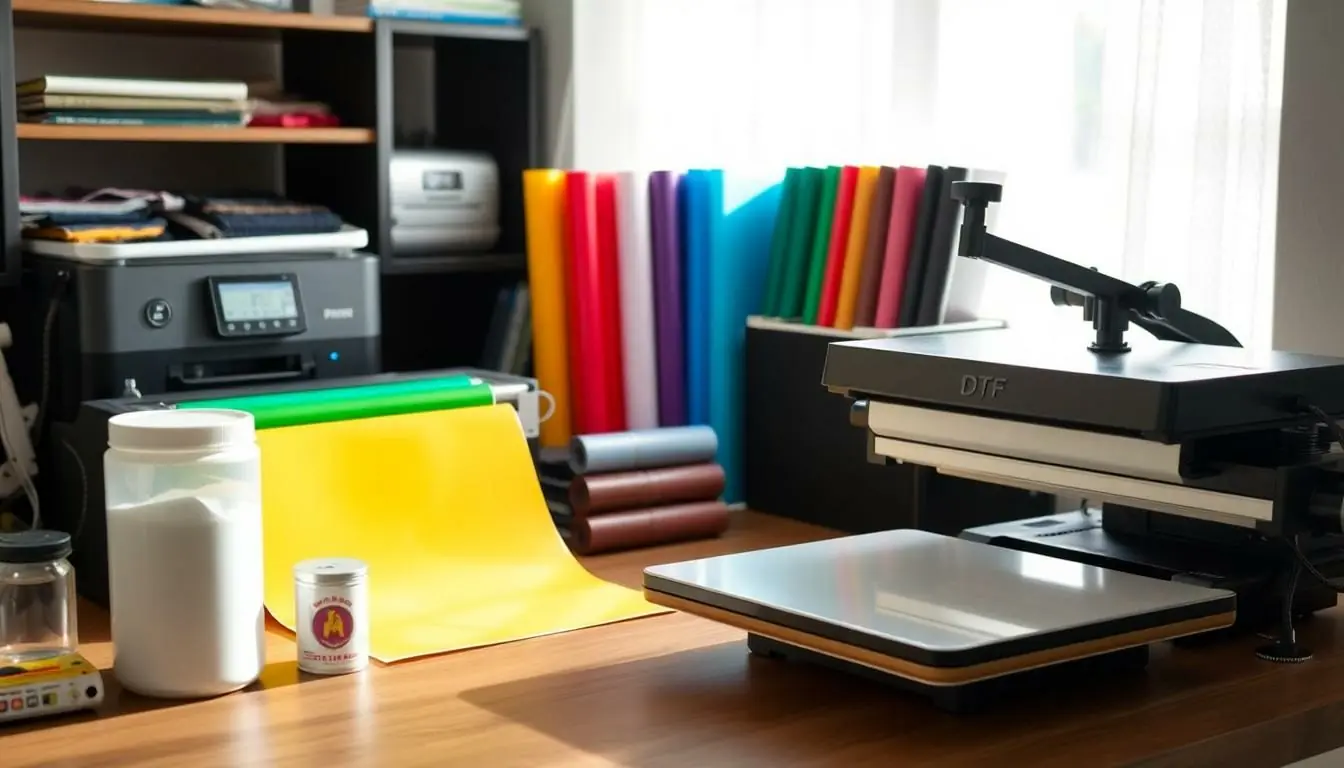Imagine turning your wildest design dreams into reality right from the comfort of your home. With DTF transfers, that’s not just a fantasy—it’s a fun weekend project waiting to happen. Whether you want to jazz up a plain tee or create custom gifts that’ll make your friends green with envy, mastering DTF transfers is the way to go.
Table of Contents
ToggleUnderstanding DTF Transfers
DTF transfers, or Direct to Film transfers, provide a method for applying vibrant designs to various surfaces at home. This technique allows individuals to customize items and explore their creativity through design.
What Are DTF Transfers?
DTF transfers involve printing designs on special film using inkjet printers. The process includes applying a powder adhesive, then curing the design, which allows for easy transfer onto fabric or other materials. This method ensures high-quality prints with intricate details and vibrant color saturation. DTF transfers work effectively on light and dark fabrics, making them versatile for numerous projects.
Benefits of DTF Transfers at Home
DTF transfers offer several advantages for hobbyists and small business owners. First, the process is relatively straightforward, requiring minimal specialized equipment. Access to customizable designs enhances creativity and personalization for unique projects. Lower costs compared to other printing methods make DTF an appealing option for home users. Lastly, DTF transfers yield durable results, as they withstand washing and wear, maintaining the integrity of the design.
Necessary Materials and Equipment

Making DTF transfers at home requires specific materials and equipment for successful results. These components create high-quality designs and ensure a smooth transfer process.
DTF Printer and Inks
DTF printers are essential for producing images on transfer film. These printers utilize specialized inks designed to adhere effectively to the film. Use high-quality pigment or water-based inks for optimal durability and vibrancy. Brands like Epson and Sawgrass provide reliable options for DTF printing. Choose a printer compatible with DTF technology to streamline production and achieve the best results.
Transfer Film and Adhesive Powder
Selecting the right transfer film impacts the quality of the final design. DTF transfer films come in matte or glossy finishes and should be chosen based on the desired look. Adhesive powder completes the process by bonding the design to the intended surface. Polyester-based adhesive powder works well for this purpose. Apply the powder evenly after printing. Ensure sufficient coverage for optimal adhesion during the heat press process.
Heat Press Machine
A heat press machine is crucial for transferring designs onto various surfaces. Use a heat press with adjustable temperature and pressure settings for precise application. Choosing a clamshell or swing-away design offers flexibility. Ensure it has a suitable size for the items being printed. Heat presses designed for DTF transfers facilitate the curing process, which provides lasting durability and enhances the vibrancy of the transferred design.
Step-by-Step Process to Make DTF Transfers at Home
Creating DTF transfers at home involves several key steps that guarantee vibrant and detailed designs on fabric.
Preparing Your Design
Begin by selecting a digital design. Use graphic design software like Adobe Illustrator or CorelDRAW to adjust the size and detail. Ensure the image resolution is high; at least 300 DPI works best for clarity. Next, flip the design horizontally. This step prevents the transfer from being printed in reverse on the fabric. Save the design in a compatible format, such as PNG or PDF, ensuring transparency if the background needs to be clear.
Printing the Transfer
Load the DTF film into the printer. Use a printer that supports DTF printing along with suitable high-quality pigment or water-based inks for optimal results. Adjust the printer settings according to the film type and quality desired. Print the design; watching the colors as they come to life on the film. Once the printing is complete, add a layer of adhesive powder evenly across the printed design. This powder will create the necessary bond to the fabric during the transfer process.
Applying the Transfer to Fabric
Position the printed transfer accurately on the fabric. Use a heat press machine set to the appropriate temperature and pressure, typically around 320°F (160°C) for 10 to 15 seconds. Apply even pressure to ensure proper adhesion. After the time is up, peel the film back gently. Check for complete transfer before washing or using the fabric. This method ensures durability and vibrant, long-lasting designs.
Tips for Successful DTF Transfers
Successful DTF transfers depend on attention to detail and avoiding common errors. Following best practices ensures high-quality results that impress.
Common Mistakes to Avoid
Skipping design preparation can lead to poor print quality. Neglecting to adjust printer settings might result in incorrect color output or misalignment. Applying adhesive powder unevenly causes inconsistent bonding, affecting durability. Improper layering of film can introduce air bubbles during heat application. Lastly, using incorrect temperature settings on the heat press may ruin the design, either by burning it or not adhering properly.
Best Practices for Quality Results
Choosing high-quality materials directly influences transfer success. Opting for branded inks and films guarantees vibrant prints. Maintaining a clean workspace prevents contamination that affects adhesion and clarity. Experimenting with test prints offers insights into adjustments needed for various fabrics. Finally, adhering to recommended heat press settings enhances transfer durability and detail.
Creating DTF transfers at home opens up a world of creative possibilities. With the right materials and a little practice anyone can achieve professional-quality designs that stand out. The straightforward process allows for customization whether for personal use or small business ventures.
By mastering the essential steps and avoiding common pitfalls individuals can enjoy vibrant and durable results. Embracing DTF transfers not only enhances creativity but also provides an affordable alternative to traditional printing methods. So gather the necessary supplies and start turning those design ideas into reality.





